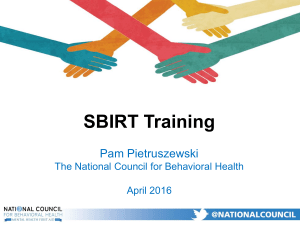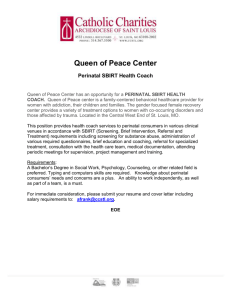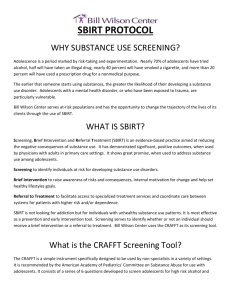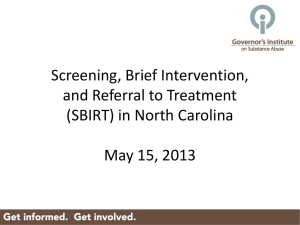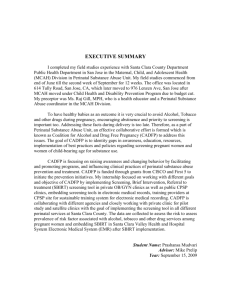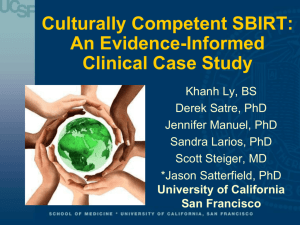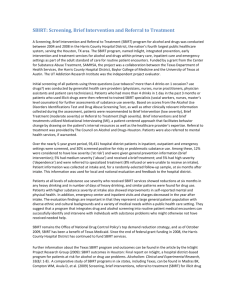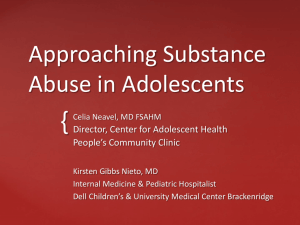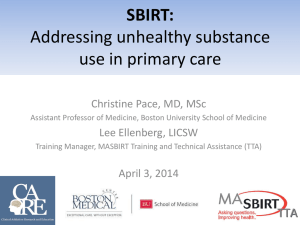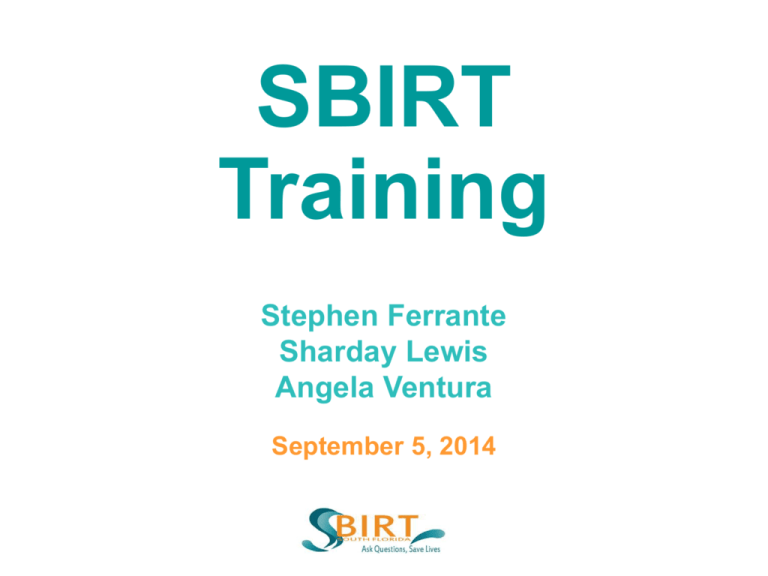
SBIRT
Training
Stephen Ferrante
Sharday Lewis
Angela Ventura
September 5, 2014
Training Components
Review & Practice
•
•
•
•
•
•
•
•
•
•
•
Overview
Prescreening
Full Screening
Motivational Interviewing
Brief Intervention
Brief Therapy & Treatment
Treatment Referral
Evaluation
Database
Billing
Organizational Adoption
http://sbirt.samhsa.gov/about.htm
Substance Abuse Severity & Level of Care
Adapted from the SAMHSA TIP #34 (1999) and Institute of Medicine (1990)
None
Mild
Moderate
Substantial
Severe
Specialized Treatment
Brief
Intervention
Primary
Prevention
Negative Screen
CRAFFT & ASSIST
Positive
Screen
CRAFFT & ASSIST
Provide Positive Reinforcement
Low Risk:
Education
Moderate Risk:
Brief Intervention
Moderate to High-Risk:
Brief Therapy
High Risk:
Refer to Treatment
SBIRT PROCESS
• Engagement & Introduction
• Consent
• Pre-Screening (CRAFFT & ASSIST)
• Full Screening (CRAFFT & ASSIST)
• Individualized Plan
• Intervention, Therapy or Treatment
• Record Activity & Process
• Follow-up Screening
• Reporting & Evaluation
DEMONSTRATION
Scenario A
http://www.youtube.com/watch?v=ZGETDcFcAbI
Scenario B
http://www.youtube.com/watch?v=uL8QyJF2wVw
Prescreening
• First Stage in SBIRT Process
• With Universal Screening - Most people screen
negative for substance misuse
• Screening is designed to be Brief & Determines:
o Any use versus no use
o Potential for risky use or serious substance use
• Demographics & Prescreen used to establish the
“Denominator” of the program:
o Total people approached & interviewed?
CRAFFT Screening Tool
• CRAFFT is an evidence based six question
behavioral health screening TOOL for youth under
21
• Developed by the Center for Adolescent Substance
Abuse Research (CeASAR), Children’s Hospital,
Boston, in affiliation with Harvard Medical School
• Recommended by the American Academy of
Pediatrics Committee on Substance Abuse for
adolescents
• Available for use in multiple languages in either a
self-administered or clinically administered version
SBIRT Preliminary Questions
The SBIRT screening protocol begins with 3 questions.
During the last 12 months, did you:
1. Drink any alcohol?
(more than a few sips)
2. Smoke any marijuana
or hashish?
3.Use anything else to get
high?
(includes illegal drugs, over-the-counter
and prescription drugs and inhalants)
If YES is given to any of these questions,
then the CRAFFT questions are administered.
CRAFFT Assessment Tool
Each positive answer, scores one point.
C
Have you ever ridden in a CAR Driven by someone (including
yourself) who was “high” or had been using Alcohol/ Drugs?
R
Do you ever use Alcohol or Drugs to RELAX ,feel better about
yourself, or fit in?
A
F
F
Do you ever use Alcohol/ Drugs while you are by yourself, ALONE?
T
Have you ever gotten into TROUBLE while you were using Alcohol
or Drugs?
Do you ever FORGET things you did while using Alcohol or Drugs?
Do your FAMILY or FRIENDS ever tell you that you should cut
down on your Drinking or Drug Use?
Interpreting CRAFFT Scores
CRAFFT SCORE
RISK LEVEL
0
No Risk
1-2
Low Risk
3-4
Moderate Risk
5-6
High Risk
Recommended Actions
Reinforcement of Positive Behavior
Brief Advice/ Information
Brief Intervention
Brief Intervention/Brief Therapy/ Referral to Treatment
1. Positive Reinforcement – Give positive feedback on current behaviors
2. Brief Advice – Use medically based information to advise abstinence
3. Brief Intervention – Educate clients and increase motivation to reduce risky behavior
(Usually 1 to 5 sessions lasting 5 mins. to 1hr .)
4. Brief Therapy - Help patients address unhealthy cognitions and behaviors associated
with current use patterns and adopt change through a limited number (typically 6 to
20) of evidence-based sessions
5. Referral to Treatment- Patients identified as needing more intensive treatment than
BI are referred to specialty SUD treatment providers
S2BI:Screening to Brief Intervention
• Developed by the Center for Adolescent Substance
Abuse Research (CeASAR), Children’s Hospital Boston, in
affiliation with Harvard Medical School
• Frequency screen that triages adolescents into risk
categories based on the DSM-5 diagnoses for SUDs
• Frequency questions are recommended for screening
adults and are used in the NIAAA Youth Alcohol Screen.
A small study at BCH also suggested they are also
accurate with teens.
S2BI
In the past year, how many times have you used
• Tobacco?
• Alcohol?
• Marijuana?
STOP if all “Never.” Otherwise, CONTINUE.
• Prescription drugs that were not prescribed for
you (such as pain medication or Adderall)?
• Illegal drugs (such as cocaine or Ecstasy)?
• Inhalants (such as nitrous oxide)?
• Herbs or synthetic drugs (such as salvia, "K2", or
bath salts)?
© Boston Children’s Hospital 2013. All Rights Reserved. For permissions contact SBIRT project manager at www.CeASAR.org.
S2BI discriminates
between 4 groups
based on DSM-5
diagnoses
Severe SUD
Mild/
Moderate SUD
No SUD
No Use
© Boston Children’s Hospital 2013. All Rights Reserved. For permissions contact SBIRT project manager at www.CeASAR.org.
DSM-5 Criteria for Substance Use Disorders
1
Use in larger amounts or for longer periods of time
Than intended
2
Unsuccessful efforts to cut down or quit.
3
Excessive time spent taking the drug
4
Failure to fulfill major obligations
5
Continued use despite problems
6
Important activities given up
7
Recurrent use in physically hazardous situations
8
Tolerance
9
Withdrawal
1
0
Craving
Severity is
determined
through number of
recorded symptoms:
•0-1:No Diagnosis
•2-3: Mild SUD
•4-5: Moderate SUD
•6 or more: Severe
SUD
American Psychiatric Association. (2013). Diagnostic and statistical manual of mental disorders (5th ed.). Arlington, VA: American Psychiatric Publishing.
© Boston Children’s Hospital 2013. All Rights Reserved. For permissions contact SBIRT project manager at www.CeASAR.org.
S2BI Results and Scoring
Administer first 3 questions. Stop if all “Never”. Otherwise, administer next set of
questions, and follow the instructions below based on the received responses.
No Use
• Provide Positive
Reinforcement of
current behaviors
Couple of
Times
• Deliver 2nd set of
questions
• Provide Brief Advice
Monthly Use
• Deliver 2nd set of
questions
• Assess further using
CRAFFT tool
• Perform
recommended
action based on
CRAFFT score
Weekly Use
• Deliver 2nd set of
questions
• Assess further using
CRAFFT tool
• Perform
recommended
action based on
CRAFFT score
No Use
• Provide Positive
Reinforcement of current
behaviors
Positive Reinforcement
• Give Positive Feedback/ Words of
Encouragement for making good decision to
delay initiation of substance use
• Emphasize teen’s decision NOT to use as
appropriate
•For younger kids include “norms
correction”
Couple of
TImes
• Deliver 2nd set of
questions
• Provide Brief Advice
Brief Advice
• Brief, medically-based advice to stop
drinking, quit smoking or quit using
marijuana.
• Talk about health consequences and
relate
advice to patient whenever possible
• Use a Strengths Based Approach,
emphasizing patient strengths and the
potential impact of alcohol, tobacco and
marijuana
© Boston Children’s Hospital 2013. All Rights Reserved. For permissions contact SBIRT project manager at www.CeASAR.org.
Monthly Use
Weekly Use
1. Administer 2nd Set of Questions
2.Assess Further Using CRAFFT Tool
3. Perform Recommended Action based on CRAFFT Score
CRAFFT SCORE
RISK LEVEL
Recommended Actions
0
No Risk
Reinforcement of Positive Behavior
1-2
Low Risk
Brief Advice/ Information
3-4
Moderate Risk
5-6
High Risk
Brief Intervention
Brief Intervention/Brief Therapy/ Referral to Treatment
© Boston Children’s Hospital 2013. All Rights Reserved. For permissions contact SBIRT project manager at www.CeASAR.org.
• The provider has valid, client self-reported information
that is used in brief intervention.
• The act of screening sets in motion a process of
client reflection on their substance use behavior, and
provides a launching point for behavior change.
Prescreening
• ASSIST Question #1
o In your life, which of the following substances
have you ever used
• Negative Screen?
o Inquire (probe) if all answers negative
o Provide feedback about the results
o Offer prevention-focused educational materials
• Positive Screen?
o Administer Full ASSIST & Determine Level of Service
• Brief intervention
• Brief treatment
• Referral to treatment
PRESCREENING
ACTIVITY
The ASSIST (World Health Organization)
• Developed by the ASSIST Working Group in 2002
• Used Primarily to Assess:
o Frequency of substance use
o Category/type of substances used
o Risk level of alcohol, illicit drugs & tobacco in past 3 months
• Illicit substances (drug use) are weighted differently for
men & women
• Use “response card” to help people being interviewed
to focus on the questions being asked
The ASSIST V3.0 – Series of 8 Questions
1. In your life, which of the following substances have you ever used? (NONMEDICAL USE ONLY) (yes/no response) PRESCREENING
2. In the past three months, how often have you used the substances you
mentioned (FIRST DRUG, SECOND DRUG, etc.)?
3. During the past three months, how often have you had a strong desire or
urge to use (FIRST DRUG, SECOND DRUG, etc.)?
4. During the past three months, how often has your use of (FIRST DRUG,
SECOND DRUG, ETC) led to health, social, legal or financial problems?
5. During the past three months, how often have you failed to do what was
normally expected of you because of your use of (FIRST DRUG, SECOND
DRUG, ETC)?
6. Has a friend or relative or anyone else ever expressed concern about your
use of (FIRST DRUG, SECOND DRUG, ETC.)?
7. Have you ever tried and failed to control, cut down or stop using (FIRST
DRUG, SECOND DRUG, ETC.)?
8. Have you ever used any drug by injection? (NON-MEDICAL USE ONLY)
ASSIST: Introduction Read to Person
Thank you for agreeing to take part in this brief interview about alcohol,
tobacco products and other drugs. I am going to ask you some questions
about your experience of using these substances across your lifetime and in
the past three months. These substances can be smoked, swallowed,
snorted, inhaled, injected or taken in the form of pills (show drug card).
Some of the substances listed may be prescribed by a doctor (like
amphetamines, sedatives, pain medications). For this interview, we will not
record medications that are used as prescribed by your doctor. However, if
you have taken such medications for reasons other than prescription, or
taken them more frequently or at higher doses than prescribed, please let
me know. While we are also interested in knowing about your use of various
illicit drugs, please be assured that information on such use will be treated
as strictly confidential.
NOTE: BEFORE ASKING QUESTIONS,
GIVE ASSIST RESPONSE CARD TO CLIENT
ASSIST Questions 6-8 focus on:
1. Others’ expressing concern about his/her substance use
2. Individual’s failed attempts to stop/cut down,
3. Injection of drugs
Example of Scoring: Cocaine/Crack
Item
(past 3 months)
Frequency
Score
Weekly
6
Once or Twice
4
Monthly
5
Once or Twice
4
Q6-d (friend or relative concern?)
Yes, but not in past 3
months
3
Q7-d (tried, but failed to cut down)
No, Never
0
Q2-d (used ?)
Q3-d (urge/desire?)
Q4-d (health, social, legal, financial
problems)
Q5-d (failed to do what was expected of you)
Total
22
Low
Risk
Moderate
Risk
Moderate
to
High Risk
Alcohol
0-10
11-19
20-26
27+
Any other
Substance
0-3
4-19
20-26
27+
No
Brief
Brief
Intervention Intervention Treatment
Referral
to
Treatment
Highest
Risk
Providing Feedback
• Low: You are at low risk of health & other problems
from your current pattern of use.
• Moderate: You are at risk of health & other problems
from your current pattern of substance use
• High: You are at high risk of experiencing severe
problems (health, social, financial, legal, relationship)
as a result of your current pattern of use & are likely to
be dependent
Ask: Are you concerned about your substance use?
Example for providing feedback: Alcohol
Your risk of experiencing these harms is:
Low
Moderate
(tick one)
High
Regular excessive alcohol use is associated with:
•
•
•
•
•
•
•
•
•
Hangovers, aggressive and violent behaviour, accidents and injury
Reduced sexual performance, premature ageing
Digestive problems, ulcers, inflammation of the pancreas, high blood pressure
Anxiety and depression, relationship difficulties, financial and work problems
Difficulty remembering things and solving problems
Deformities and brain damage in babies of pregnant women
Stroke, permanent brain injury, muscle and nerve damage
Liver disease, pancreas disease
Cancers, suicide
FULL
SCREENING
ACTIVITY
BRIEF INTERVENTION
• 1 to 5 Sessions
• Advise
o Review screening results
o Provide direct advice to make a change
o Educate on substances & substance use/abuse
o Consequences of use & benefits of change
• Assess
o Determine how willing the client is to change his/her behavior
o Reinforce client’s capacity for change
• Agree
o Set concrete goals
• Assist
o Help client to make change if he/she is ready
o Outline strategies for success & relapse prevention
Brief Intervention Tools
• Individual Record & Plan
• Health Promotion Workbook
• Brief Negotiated Interview Tips
• Educational Materials: Drug Fact Sheets
BRIEF
INTERVENTION
ACTIVITY
BRIEF
TREATMENT
A 16-session
curriculum
manual for
conducting brief
treatment
Dupree & Schonfeld
(CSAT, 2005)
Content of 16 Sessions
Topics
#
Sessions
Introduction to Analysis of Behavior (“A-B-C’s” of
Substance Abuse)
2
Social Pressure
2
At Home and Alone
1
Depression
2
Managing Anxiety & Tension
3
Managing Anger & Frustration
3
Controlling Cues
1
Coping with Urges
1
Preventing a Slip from Becoming A Relapse
1
“A-B-C” Approach to Treatment: The Substance Use Behavior Chain
Antecedents
Situations/ + Feelings + Cues + Urges
Thoughts
Behavior
1st drink or
Use of drug
Consequences
Immediate
Positive or
Negative
Long Term
Negative
Consequences
Home/alone + bored and depressed +
beer in refrigerator + “A drink will help
me forget my troubles.”
First sip
of beer
Feel happier
Continue drinking,
anger her children,
and impair health
Teaching the Skills Necessary to Prevent Relapse
Once the person demonstrates an understanding of his/her personal substance use
behavior chain, teach specific skills to address his or her high risk situations
CBT & Self-Management Skills
High Risk Situation
Social Pressure
Loneliness
Depression
Anxiety
Anger/Frustration
Cues
Urges
Slips
Skills Taught
Drink Refusal
Rebuild Social Network
Cognitive Restructuring
Thought-stopping
Relaxation, Problem solving
Thought-stopping
Assertiveness Training
How to dispose, avoid, rearrange
Thought-stopping, Learn to Delay
Relapse Training
Referral to Treatment
• Arrange
oTreatment & Supportive Service Referrals & Linkages
oBased on Client Risks & Needs
oConfirm Connections
• Local County Treatment Providers
• Established Relationships
oReferral Agreements
• Follow-up RE: Treatment Completion &
Outcome
• Offering Continued Availability & Support
SBIRT Evaluation (2 years)
• Evaluating Output
o Client Reach
o Productivity
• Evaluating Outcome
o Compare baseline with 60 day post intervention/treatment
follow-up
• Evaluating Process
o Adoption strategies
o Protocols
o Challenges & Success
Evaluation Tools
• Voluntary Content
• Follow-up Consent
• Individual Record & Plan
• Monthly Report
• Provider Meetings
• Stakeholder Interviews / Focus Groups
• Steering & Advisory Council
DATABASE
DEMONSTRATION
& DIALOGUE
www.collaborateandgrow.com/sbirt
SBIRT Billing & Reimbursement
• Affordable Care Act Recommended Service
• Screening & Brief Intervention Reimbursement
oCommercial insurance CPT codes
oMedicare G codes
oMedicaid HCPCS codes
• Florida Medicaid Billing Codes not approved
Payer
Commercial
Insurance
Code
Alcohol and/or substance abuse structured
CPT 99408 screening and brief intervention services;
15 to 30 minutes
$33.41
Alcohol and/or substance abuse structured
CPT 99409 screening and brief intervention services;
greater than 30 minutes
$65.51
G0396
Alcohol and/or substance abuse structured
screening and brief intervention services;
15 to 30 minutes
$29.42
G0397
Alcohol and/or substance abuse structured
screening and brief intervention services;
greater than 30 minutes
$57.69
H0049
Alcohol and/or drug screening
$24.00
H0050
Alcohol and/or drug service, brief
intervention, per 15 minutes
$48.00
Medicare
Medicaid
Description
Fee
Schedule
Common Behavioral Health Codes
CPT Code
Description
90801
Diagnostic interview
90804
Individual psychotherapy, 20‒30 minutes
90806
Individual psychotherapy, 45‒50 minutes
SBIRT Billing Codes
• October 14, 2011 CMS began covering annual alcohol screening & for
those that screen positive up to 4 brief, face-to-face behavioral counseling
interventions annually for Medicare beneficiaries including pregnant
women. Each of the 4 behavioral counseling interventions must be
consistent with the 5As approach:
• Assess: Ask about/assess behavioral health risk(s) and factors affecting
choice of behavior change goals/methods.
• Advise: Give clear, specific, and personalized behavior change advice,
including information about personal health harms and benefits.
• Agree: Collaboratively select appropriate treatment goals and methods
based on the patient’s interest in and willingness to change the behavior.
• Assist: Using behavior change techniques (self-help and/or counseling),
aid the patient in achieving agreed-upon goals by acquiring the skills,
confidence, and social/environmental supports for behavior change,
supplemented with adjunctive medical treatments when appropriate.
• Arrange: Schedule follow-up contacts (in person or by telephone) to
provide ongoing assistance/support and to adjust the treatment plan as
needed, including referral to more intensive or specialized treatment.
Health Care Providers can provide
SBIRT services under Medicare
• Medicare pays for medically reasonable & necessary SBIRT
services in physicians’ offices & outpatient hospitals
• Physicians, Physician Assistants, Nurse Practitioners,
Clinical Nurse Specialists, Clinical Psychologists, or Clinical
Social Workers can bill for SBIRT
• To bill Medicare, providers of MH services must be:
o Licensed or certified to perform mental health services
by the state in which they perform the services;
o Qualified to perform the specific mental health services
rendered; and
o Working within their State Scope of Practice Act
http://www.cms.gov/Outreach-and-Education/Medicare-Learning-NetworkMLN/MLNProducts/Downloads/SBIRT_Factsheet_ICN904084.pdf
Centers for Medicare & Medicaid (CMS)
SBIRT Billing Codes – October 2011
• Two new G codes, G0442 (Annual Alcohol Misuse Screening, 15
minutes), and G0443 (Brief face-to-face behavioral counseling for
Alcohol Misuse, 15 minutes)
• Provider specialty types that may submit claims under these codes:
01-General Practice
08-Family Practice
11-Internal Medicine
16-Obstetrics/Gynecology
37-Pediatric Medicine
38-Geriatric Medicine
42-Certified Nurse Midwife
50-Nurse Practitioner
89-Certified Clinical Nurse Specialist
97-Physician Assistant
Organization Adoption
• Information & Knowledge Sharing
• Commitment & Buy-In
• Protocols
• Tools & Materials
• Practice Integration
• Fidelity Checks
• Professional Development & Competence
• Data Management
• Continuous Quality Improvement
• Sustainability
• Coaching & Technical Assistance
QUESTIONS
COMMENTS
& FEEDBACK
CERTIFICATES
& EVALUATIONS

